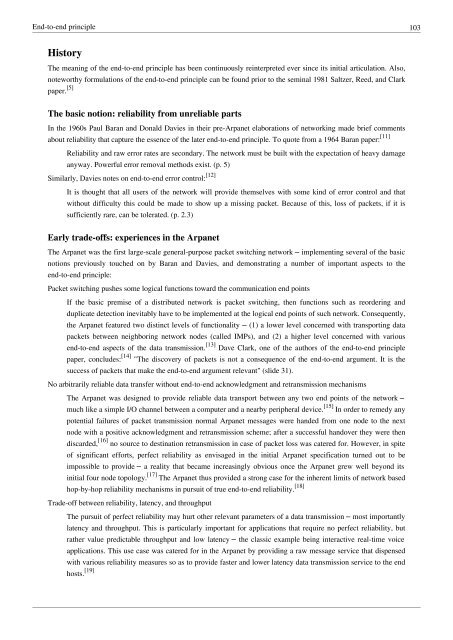Internet Protocol - Research by Kirils Solovjovs
Internet Protocol - Research by Kirils Solovjovs
Internet Protocol - Research by Kirils Solovjovs
You also want an ePaper? Increase the reach of your titles
YUMPU automatically turns print PDFs into web optimized ePapers that Google loves.
End-to-end principle 103<br />
History<br />
The meaning of the end-to-end principle has been continuously reinterpreted ever since its initial articulation. Also,<br />
noteworthy formulations of the end-to-end principle can be found prior to the seminal 1981 Saltzer, Reed, and Clark<br />
paper. [5]<br />
The basic notion: reliability from unreliable parts<br />
In the 1960s Paul Baran and Donald Davies in their pre-Arpanet elaborations of networking made brief comments<br />
about reliability that capture the essence of the later end-to-end principle. To quote from a 1964 Baran paper: [11]<br />
Reliability and raw error rates are secondary. The network must be built with the expectation of heavy damage<br />
anyway. Powerful error removal methods exist. (p. 5)<br />
Similarly, Davies notes on end-to-end error control: [12]<br />
It is thought that all users of the network will provide themselves with some kind of error control and that<br />
without difficulty this could be made to show up a missing packet. Because of this, loss of packets, if it is<br />
sufficiently rare, can be tolerated. (p. 2.3)<br />
Early trade-offs: experiences in the Arpanet<br />
The Arpanet was the first large-scale general-purpose packet switching network – implementing several of the basic<br />
notions previously touched on <strong>by</strong> Baran and Davies, and demonstrating a number of important aspects to the<br />
end-to-end principle:<br />
Packet switching pushes some logical functions toward the communication end points<br />
If the basic premise of a distributed network is packet switching, then functions such as reordering and<br />
duplicate detection inevitably have to be implemented at the logical end points of such network. Consequently,<br />
the Arpanet featured two distinct levels of functionality – (1) a lower level concerned with transporting data<br />
packets between neighboring network nodes (called IMPs), and (2) a higher level concerned with various<br />
end-to-end aspects of the data transmission. [13] Dave Clark, one of the authors of the end-to-end principle<br />
paper, concludes: [14] "The discovery of packets is not a consequence of the end-to-end argument. It is the<br />
success of packets that make the end-to-end argument relevant" (slide 31).<br />
No arbitrarily reliable data transfer without end-to-end acknowledgment and retransmission mechanisms<br />
The Arpanet was designed to provide reliable data transport between any two end points of the network –<br />
much like a simple I/O channel between a computer and a near<strong>by</strong> peripheral device. [15] In order to remedy any<br />
potential failures of packet transmission normal Arpanet messages were handed from one node to the next<br />
node with a positive acknowledgment and retransmission scheme; after a successful handover they were then<br />
discarded, [16] no source to destination retransmission in case of packet loss was catered for. However, in spite<br />
of significant efforts, perfect reliability as envisaged in the initial Arpanet specification turned out to be<br />
impossible to provide – a reality that became increasingly obvious once the Arpanet grew well beyond its<br />
initial four node topology. [17] The Arpanet thus provided a strong case for the inherent limits of network based<br />
hop-<strong>by</strong>-hop reliability mechanisms in pursuit of true end-to-end reliability. [18]<br />
Trade-off between reliability, latency, and throughput<br />
The pursuit of perfect reliability may hurt other relevant parameters of a data transmission – most importantly<br />
latency and throughput. This is particularly important for applications that require no perfect reliability, but<br />
rather value predictable throughput and low latency – the classic example being interactive real-time voice<br />
applications. This use case was catered for in the Arpanet <strong>by</strong> providing a raw message service that dispensed<br />
with various reliability measures so as to provide faster and lower latency data transmission service to the end<br />
hosts. [19]


